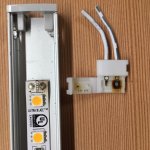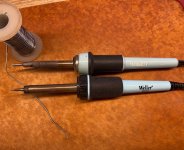I've got a big floor-to-ceiling/wall-to-wall bookcase to piece together in the coming days. I've designed it in 5 sections that can be attached to one another.
In practice this means that I've got five 2m x 0.75m caracsses to construct - normal 'ladder' format with a 18mm backing.
1 x 18mm MRMDF back
2 x 18mm MRMDF sides
5 x 25mm MRMDF shelves (lipped front and back with hardwood)
2 x 18mm MRMDF tops and bottoms
I'm wondering how much I should be using my domino? I have a pocket hole jig, and 4 1200mm paralell clamps - but being relatively light on clamps and working single handedly, I'm leaning towards using more screws and pocket holes, but wondering how the Domino might help avoid that 'pull' that often occurs as pocket screws gets tightened - which pulls things a milimitre or so out; and also whether adding more glue/dominos is worth the effort, stress and risk of mishap...
I was planning on doing the following, constructing the outer carcass first, then installing the shelves later. I'd be really grateful for any advice as to the merits of my approach:
Carcass
- Construct the outer carcass using pocket holes and a little glue. I'd drill pocket holes along the edges of the two 'sides' and two 'tops/bottoms' to that they can be screwed to each other and the 18mm bookcase 'back'. I'd put a pocket hole every 12" or so
- Against for the outer carcass, I wonder whether pocket holes are enough and whether I should use glue for strength and/or dominos for alignment. I figure that I can clamp the outer carcass pretty well and can even dry fit some of the internal shelves to avoid the pocket holes 'pulling in' as they tighten. I'm worried about this, as I have it happen quite frequently when using pocket holes, but in this case, the carcass really needs to be millimetre perfect. I'm wondering whether using dominos would counteract this 'pull' effectively.
Shelves
- Using glue and dominos for the shelf sides would have needed to have been done when I constructed the carcass. But I think gluing the carcass, shelves, dominos, assembling it all, clamping, dealing with squeeze out etc all is too much for me working on my own (and not very experienced). I also don't want to use pocket holes on the shelves as would like to avoid all the hole filling that would be required.
- I'm wondering whether screws alone (drilled from the outside of the carcass, that will eventually be hidden) into the sides and rear of each shelf will be sufficient? Or should I use dominos/glue across the back edge of the shelf?
- If I just use screws, things seem simple - I'd lie the carcass on its back, make spacers from scrap to define my shelf heights, dry fit the shelves, use my kreg 90 degree clamps to hold them in place, and start adding screws along each side and the rear.
- Alternatively, I could use dominos and glue across the back of the shelf. For this, I figure I'd need to make my spacers from scrap, drill domino holes in the rear carcass and rear edge of the shelf. Apply glue, position shelf, clamp and screw as above. Not sure if the domino/glue along the back of the shelf is necessary - it certainly adds complication and I'd have to carefully think through how I reference with the domino.
I guess the significant thing in this approach is that I'm not trying to glue my shelves in as I construct the main carcass. In my head that 'feels' like a better/higher quality/stronger approach, but I'm not sure I've got the skills to do so much gluing, positioning, clamping, screwing etc without either the glue drying or creating a massive mess.
Thanks
In practice this means that I've got five 2m x 0.75m caracsses to construct - normal 'ladder' format with a 18mm backing.
1 x 18mm MRMDF back
2 x 18mm MRMDF sides
5 x 25mm MRMDF shelves (lipped front and back with hardwood)
2 x 18mm MRMDF tops and bottoms
I'm wondering how much I should be using my domino? I have a pocket hole jig, and 4 1200mm paralell clamps - but being relatively light on clamps and working single handedly, I'm leaning towards using more screws and pocket holes, but wondering how the Domino might help avoid that 'pull' that often occurs as pocket screws gets tightened - which pulls things a milimitre or so out; and also whether adding more glue/dominos is worth the effort, stress and risk of mishap...
I was planning on doing the following, constructing the outer carcass first, then installing the shelves later. I'd be really grateful for any advice as to the merits of my approach:
Carcass
- Construct the outer carcass using pocket holes and a little glue. I'd drill pocket holes along the edges of the two 'sides' and two 'tops/bottoms' to that they can be screwed to each other and the 18mm bookcase 'back'. I'd put a pocket hole every 12" or so
- Against for the outer carcass, I wonder whether pocket holes are enough and whether I should use glue for strength and/or dominos for alignment. I figure that I can clamp the outer carcass pretty well and can even dry fit some of the internal shelves to avoid the pocket holes 'pulling in' as they tighten. I'm worried about this, as I have it happen quite frequently when using pocket holes, but in this case, the carcass really needs to be millimetre perfect. I'm wondering whether using dominos would counteract this 'pull' effectively.
Shelves
- Using glue and dominos for the shelf sides would have needed to have been done when I constructed the carcass. But I think gluing the carcass, shelves, dominos, assembling it all, clamping, dealing with squeeze out etc all is too much for me working on my own (and not very experienced). I also don't want to use pocket holes on the shelves as would like to avoid all the hole filling that would be required.
- I'm wondering whether screws alone (drilled from the outside of the carcass, that will eventually be hidden) into the sides and rear of each shelf will be sufficient? Or should I use dominos/glue across the back edge of the shelf?
- If I just use screws, things seem simple - I'd lie the carcass on its back, make spacers from scrap to define my shelf heights, dry fit the shelves, use my kreg 90 degree clamps to hold them in place, and start adding screws along each side and the rear.
- Alternatively, I could use dominos and glue across the back of the shelf. For this, I figure I'd need to make my spacers from scrap, drill domino holes in the rear carcass and rear edge of the shelf. Apply glue, position shelf, clamp and screw as above. Not sure if the domino/glue along the back of the shelf is necessary - it certainly adds complication and I'd have to carefully think through how I reference with the domino.
I guess the significant thing in this approach is that I'm not trying to glue my shelves in as I construct the main carcass. In my head that 'feels' like a better/higher quality/stronger approach, but I'm not sure I've got the skills to do so much gluing, positioning, clamping, screwing etc without either the glue drying or creating a massive mess.
Thanks



